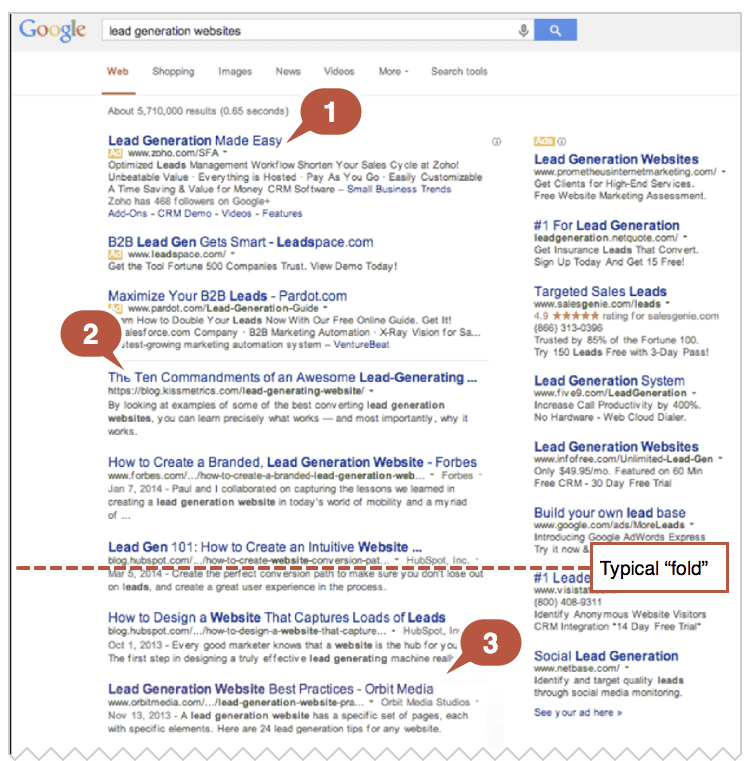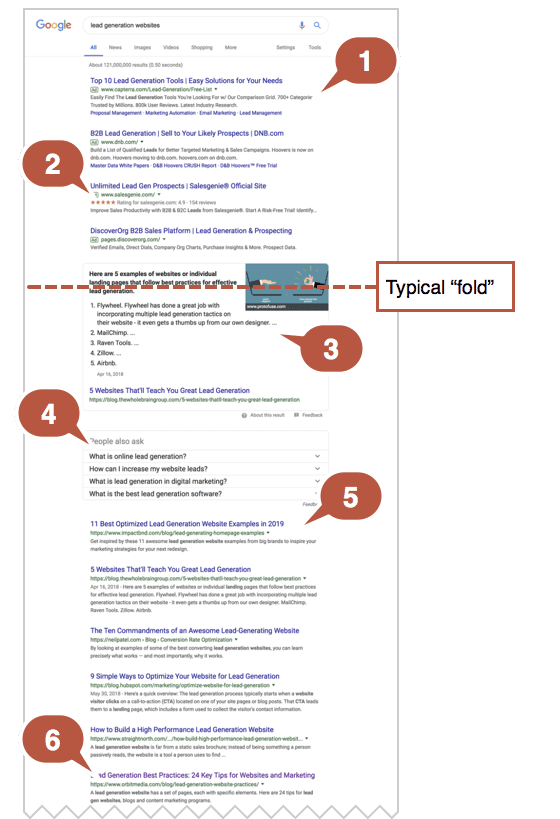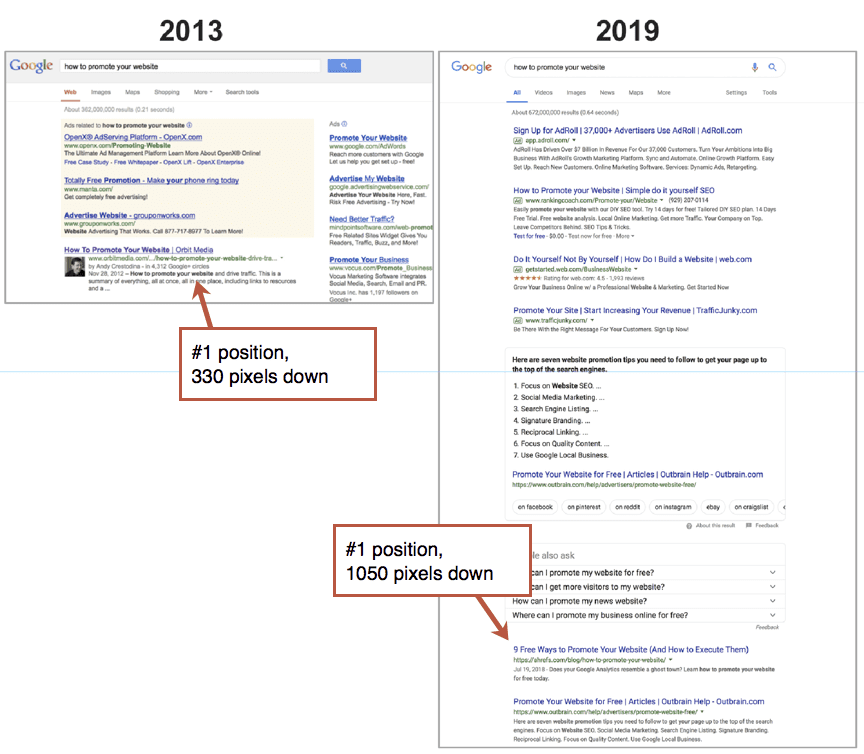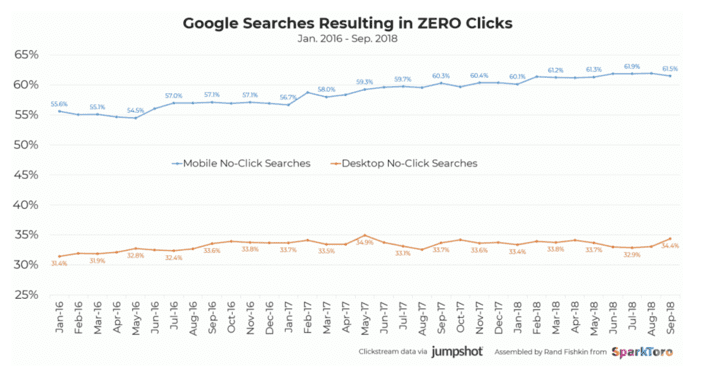Top SEO Trends at Google

At conferences we often hear:
"Google is changing every day ..."
"The Google algorithm is updated 500 times a year ..."
"You must stay in the top of the issue ..."
A change in Google means a change in ranking, right?
But what if the biggest changes to Google have nothing to do with ranking?
')
Yes, Google is constantly changing. And yes, changes affect your traffic.
However, the biggest SEO trends do not affect your place in the issue.
They affect your CTR.
And this is a big difference.
Traveling with me in the past ...
Five years ago, a typical search results page looked completely different. I have an archive of old screenshots, so it will be fun. Just by looking at them, you can identify obvious SEO trends.
If in 2014 you were searching for “lead generation websites”, then that’s what you found.

Feel nostalgic? Old google logo.
But how else are these pages different?
1. Ads are more visible
The little icon next to each ad was bright yellow. There was even a line that separated the advertising from the organic issue. And all these ads were in the right column.
2. The organic top is about 450 pixels below.
Assuming that the average fold for the desktop is 700 pixels, the top 3 ads in organic output are visible without scrolling.
3. I am issuing the fourth
800 pixels down the page. We will come back to this.
Now let's look at the same search today, in 2019.

Huge changes. And they highlight the main SEO trends:
1. Less ads
Here you see four ads, not 12. That's less, right?
Not really, if you count the links under the ads, they are 11.
Thus, the number of links to advertisers is still large.
And the ad icon is much less noticeable. He merges.
Ads have become like organic issue.
2. Seller rating
One of the advertisers has stars.
3. Giant snippet
It is large and is in the top of the issue and combines text from one page and image
with another. The user can get all the necessary information without going
on the ad.
4. Block related questions
The “People are also looking for” search carousel gives the user more opportunities to interact and get information without leaving the SERP. And it pushes down SEO.
5. The organic top is at 2600 pixels below.
Below the first scroll screen.
6. I am issuing the sixth
This is two places lower. Not a big difference. But the actual situation?
3000+ pixels down the page.
Place in the issuance has changed slightly (from # 4 to # 6), but the situation has changed significantly. 800 pixels depth versus 3900 pixels depth
Position in search results is durable. Position - no
Surprised by how little SEO has changed in five years? Me not!
In my experience, pages that are well ranked tend to continue to rank well over a long period of time.
After five years, our page still holds a good position.
What influences the situation in SEO-issue?
Changes in the ranking algorithm are real, but much larger SEO trends are “issue elements,” such as snippets, maps, and videos.
Here is a list of the elements of the issue that you see in the search results every day.
You can see when they first appeared and the likelihood that they will appear in 2019, according to MozCast.

Note: Mozcast is constantly updated. The chart reflects percentages at the time of writing.
Here is another example, before and after, 2015 and 2019:

Top rated pages are not ranked as high as before. They are below the issue elements. In this case, it is advertising, snippets and a block of related issues.
Here is another one:

Let's take another one:

This is fun, because back in 2013, advertising still had a colorful background, clearly highlighting them.
This was also the end of the era of Google authorship, when Google showed the faces of content creators in search results. This program was canceled, presumably because
that it increased the clicks on the websites and reduced the clicks on the ads.
What does this mean for traffic?
Over the years, more and more users find answers immediately in the issue, using various elements of the issue. Because of this, sites began to receive less traffic.

61% of mobile search and 33% of the desktop does not lead to a click.
This is 5.6 billion Google searches per day.
Approximately 250 million fewer visits to websites every day.
So this is a mega trend in SEO:
more answers in search results and less clicks on the ad.
Even if your position in the issuance does not change, over time you will notice a drop in CTR.

But there are examples, as with the growth of the position in the issuance, the traffic became even smaller.
This makes life difficult for SEO agencies.
“Yes, I know that traffic has dropped, but the position in the issue has grown.”
What to do with the growth of search elements and the fall in CTR?
Do not despair. Google is still an excellent and inexpensive source of quality traffic for most websites.
But as Google changes, so must we.
To keep traffic flowing, I recommend the following tips and methods:
- Target phrases with fewer search results.
Often these are longer, non-commercial phrases. - Fight for extended snippets. (Here is the guide )
- Use semantics correctly. (here is the guide )
- Increase your email base.
The larger your base, the less you rely on digital giants. - Write for other sites. This does not increase your traffic, but publishing on reputable websites can do wonders for the visibility of your content.
- Increase the amount of content targeted to key phrases.
There are millions more options for key phrases
“I would also think about how to keep a visitor to your site.
Think about the user's path. What does he want to know after searching for a specific query? Include it in your content! Thus, you will reduce the% of failures, and the user will find what he needs. ”Dan Shure
More SEO trends
Here are some more basic SEO trends, starting with the main one, about which we only
what they said.
1. The increase in search results items, including snippets and a block of related issues, leads to a decrease in CTR and traffic to the site.
2. Increase the share of voice search.
According to a BrightLocal survey, 58% of consumers used voice search last year to search for local businesses.
3. Increase mobile search.
According to Statista , 60% of Google’s search queries come from mobile devices. 5 years ago he was at the level of 34%.
In five years, it has almost doubled.
“I need to hire someone to support my SEO ...”
We often hear it.
I answer with the simple question “what kind of SEO support do you mean?”
Usually, after a short silence, they explain that they want to maintain their position in the issuance of several specific phrases.
Just think about it!
There are things much more important than the place in the issuance.
Subscribe to my telegram channel (@proroas), writing about digital marketing, services and analytics. About what I use in work myself.
Source: https://habr.com/ru/post/451874/
All Articles